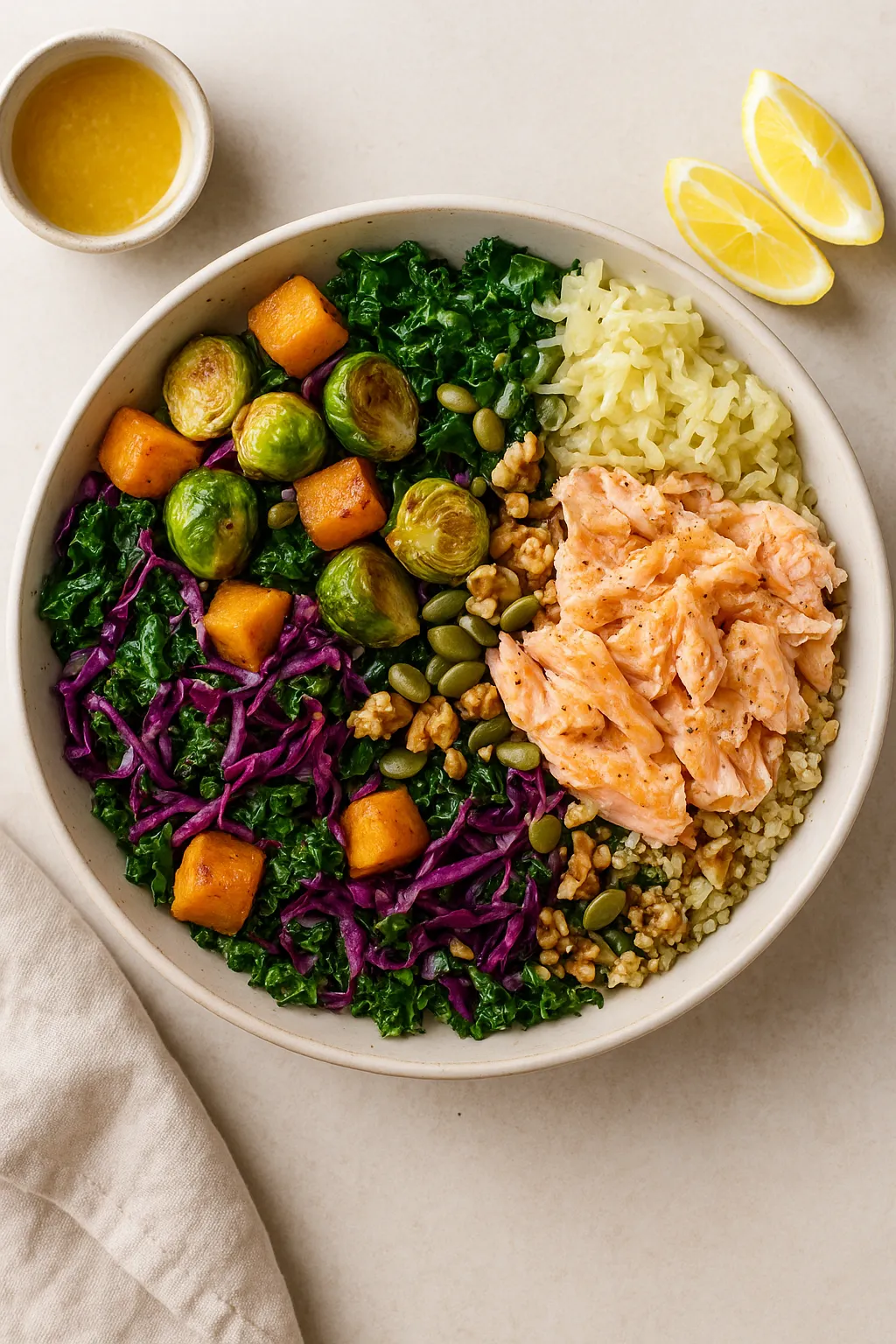
Fall Harvest Salad
Fall Harvest Gut-Boost & Protein Salad (Serves 4)
By: Ruth-Anne Lindsey
As we age, keeping our gut microbiome diverse becomes more important for digestion, nutrient absorption, immune health, and even mood. A colorful mix of seasonal veggies—cruciferous greens, root vegetables, and fermented foods—gives the gut a wide variety of fibers and plant compounds (prebiotics) that feed beneficial microbes. Adding a quality protein and healthy fats supports tissue repair and helps maintain muscle mass, which is especially important for women over 60. This harvest salad combines roasted fall vegetables, probiotic sauerkraut, quinoa, pumpkin seeds, and flaky salmon for a satisfying, nutrient-dense meal that’s gentle on digestion and full of seasonal flavor.
Curious how your gut health affects the way you age? In just 20 minutes, my Aging Powerfully Masterclass will show you why your microbiome is key to vitality, energy, and nutrient absorption—especially for women over 60. Watch the Aging Powerfully Masterclass Now Here and take the first step toward feeling your best this fall!
Ingredients (serves 4)
4 salmon fillets (about 4 oz / 113 g each; total ~452 g) — baked or pan-seared
1 cup cooked quinoa (about 185 g cooked)
3 cups butternut squash, peeled & cubed (about 400 g)
2 cups Brussels sprouts, halved (about 200 g)
2 cups shredded red cabbage (about 150 g)
3 cups chopped kale, stems removed (about 120 g)
1 medium carrot, shredded (≈70 g)
½ cup thinly sliced red onion (≈58 g)
1/4 cup pumpkin seeds (30 g)
2 tbsp chopped walnuts (≈20 g)
1/2 cup sauerkraut (≈75 g) — optional but recommended for probiotics
3 tbsp extra-virgin olive oil (for dressing & roasting; ≈42 g total)
1 tsp maple syrup (≈5 g) — for dressing
1 tbsp Dijon mustard (≈15 g)
2 tbsp apple cider vinegar (or more to taste)
Salt & pepper to taste
Optional: a squeeze of lemon over salmon and salad
Directions
Preheat & prep: Preheat oven to 400°F (200°C). Line a roasting pan with parchment. Rinse quinoa and cook according to package directions (1 cup dry usually makes ~2–3 cups cooked; this recipe uses 1 cup cooked). Set quinoa aside to cool slightly.
Roast the squash & Brussels: Toss butternut squash cubes and halved Brussels sprouts with 1 tbsp olive oil, ½ tsp salt and pepper. Spread in a single layer and roast 22–30 minutes, tossing once, until browned and tender. (Smaller pieces cook faster.)
Prepare kale & cabbage base: While veggies roast, massage chopped kale with a light pinch of salt and a teaspoon of olive oil for 1–2 minutes (this softens it). Place the mashed kale in a large serving bowl with shredded red cabbage, shredded carrot, and sliced red onion.
Cook the salmon: Season salmon fillets with salt, pepper, and a squeeze of lemon. Either pan-sear (skin side down first, 4–5 min per side depending on thickness) or bake at 400°F for ~10–14 minutes until cooked through and flaky. Let rest 2 minutes, then flake into large pieces.
Make dressing: In a small jar or bowl whisk together 2 tbsp olive oil (reserve 1 tbsp for roasting if you prefer), 2 tbsp apple cider vinegar, 1 tsp maple syrup, and 1 tbsp Dijon mustard. Taste; add a pinch of salt and pepper. Shake or whisk until emulsified.
Assemble: Add cooked quinoa, roasted squash, roasted Brussels sprouts, pumpkin seeds, and walnuts to the kale/cabbage bowl. Pour dressing over and toss gently to combine. Add sauerkraut (start with 2–3 tbsp per serving as desired). Top each portion with a salmon fillet or divide the flaked salmon into four portions on top.
Serve: Finish with an extra squeeze of lemon if you like. Serve warm or at room temperature.
Make-ahead & swaps: Roast veggies and cook quinoa a day ahead. Swap salmon for grilled chicken or tempeh for a vegetarian option (tempeh will change macronutrient totals). Reduce sauerkraut if you’re sodium-sensitive.
Estimated nutrition (per portion)
These are estimates based on standard nutrient values for the ingredients listed.
Calories: 571 kcal
Protein: 35.13 g
Fat: 33.12 g
Carbohydrates: 37.24 g
Fiber: 9.15 g
Sugar: 7.87 g
Quick Notes:
Fiber variety matters: different veggies provide different fibers and polyphenols — feeding diverse microbes.
Fermented foods like sauerkraut add live microbes (start small if you’re new to them).
Protein + healthy fats help with tissue repair and satiety — salmon brings omega-3s that reduce inflammation.
If chewing is a concern, dice veggies smaller or lightly steam roasted pieces; salmon flakes are easy to eat and digest.
Ready to take your fall wellness to the next level? I’d love to guide you personally! Book your Free Nutrition Consultation with me today, and let’s create a simple, gut-friendly plan that supports digestion, energy, and overall health.

